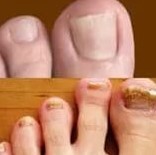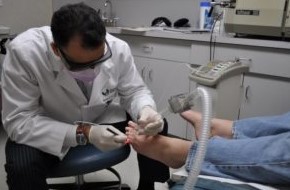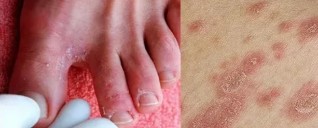A fungal infection of the toe nails are also common. There are many different types of nail fungus and the treatment depends on the type of pathogen. The cause of the disease is the lack of hygiene, but in many they have throughout the working day to be in your shoes.

The essence of the infection and the progression of the disease is not in contact with fungal spores dead skin. Micro-organisms can penetrate into all the cracks, bumps, roughness, loss. In almost all cases the fungus passes on to the nails, which they immediately began to take on an unhealthy appearance.
The main
Itching, and changes in the nail plate is a common symptoms that are observed in all of its forms. There are a number of special characters, depending on the type of pathogen. So, what kinds of fungi are there?
Dermatophyte
This form is to be developed, in contact with the pathogens Trichophyton, Microsporum, and Epidermophyton.
The man is suffering from any of the following symptoms:
- the appearance of gray, with yellow bands on the plate. The first spots to appear on one of the nail, moving onto a nearby;
- the nail will gradually begin to lag behind the bed.
Dance
Mold can affect not only the products but also your skin and nails. The main symptom of this form of fungal disease is a change in color.
With a healthy pink tint to become an ugly black, brown or green. Anything less, is a common symptom is the formation of blackheads, pimples.

Yeast
Due to the infection of the fungus Candida. A negative feature is the high probability of defeat of a full-stop. The main symptoms are the following:
- The nail surface becomes much thinner, which makes them break down faster.
- Of the nail plate, if you want to change the color of the structure.
- With the development of the disease have a more powerful exfoliation.
- Her fingers constantly swell and become red.
The infection spreads through the humidity. For this reason, it is important to follow some precautions when you visit the swimming pool, the public bath.
The classification according to the degree of the development of the
If you want to be the most effective treatment, the doctor needs to determine what level of development they have reached of the disease, that is, to correctly determine the level of the fungus on the feet. With the development of the infection in the pathology has already spread not only to the close of the nail, but also on the skin, have an impact on the whole of the foot.

The forms of the disease, which is based on the stage of its development:
- Normotroficheskie, in which there is a change in the color of the nails, and the lines, but the shape itself does not change. This is the initial stage of the infection.
- Hypertrophic scars, which has changed the nail. It is very easy to spoil, it becomes thin, thereby making the patient much inconvenience.
- Atrophic. The panel, in this case, it is a lot thinner, she calmed down, the shape of the nail is bent, and it is a fast game. At this stage, the nail plate will begin to move away from the bed. The treatment here is quite severe, as the disease begins to take on a run of form.
A competent one
To get rid of the disease is possible only with the help of a competent treatment. It depends on the type of fungus and you will need to depend on the stage of the disease.
The doctor who carries out a medical expert examination, establishes the form and the nature of the fungus, the study of the individual characteristics of the organism, and the required treatment.
The selection of the circuit board
Medicine offers three main treatment regimens – systemic, comprehensive, and the treatment of foreign funds. In the first case, it is assumed the intake of medicines in form of tablets or capsules. Many of them have a lot of side effects.
In the complex therapy, the treatment is not only a tablet but also, for the of the drug. Once outside, there is a minimum number of side-effects, because the system is, the better.
The important point is the current treatment helps only in the early stages of the disease, that is, if the impact is less than one-third of the nail plate and no more than two legs.

At the time of the treatment, at all levels and in all forms, they are assigned to a variety of external treatment methods. We are talking about creams, nail polishes, and solutions. With them the impact of the sole on the fungus of the nails of the feet, without affecting nearby tissue.
Among the external agents for the treatment of a commonly used variety of creams. Not only do they effectively remove all signs of disease, but also to soften and moisturize the nails, the reduction in the value of indicators of discomfort. Regardless of the method chosen, the treatment of the fungus, and the preparation is very important to follow the instructions of the expert, and medications. The only way to achieve the positive results of the treatment. The only way of healing will provide an antifungal effect and an optimum antibacterial effect.
The number of applications and technologies depends on the drug and on the type of mold and the shape of its development. Usually, it is two to three times a day.
If you are using an external means for the treatment of the fungus, prior to any use, it must be removed with special tools, keratinized. This will increase the penetrating ability of the drug, and it helps a lot more quickly, in order to achieve a positive effect, regardless of the type of fungus.
A summary of the
The total duration of the treatment of the fungus, the average is 6 months, and then observed the growth of the non-updated of the nail plate. To achieve this, the outcome of the treatment is usually does not stop, it has to go on, as long as, as long as you don't reach a long-lasting effect and does not completely prevent the recurrence of the disease.






























